South Australia
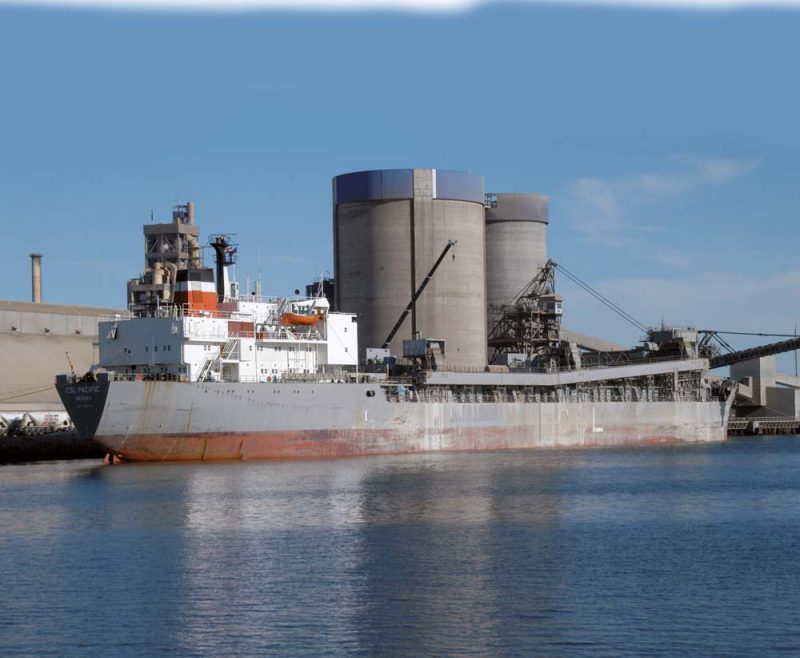
The Flinders Range of mountains is a chain extending for 400 kilometres from the head of the Spencer Gulf, and reaches 1,190 metres in height to St. Mary’s Peak, with the range of mountains named after Capt. Matthew Flinders. The Spencer Gulf lies between the Yorke peninsula to the east and the Eyre peninsula to the west of South Australia. Investigator Strait and Gulf St. Vincent to the north of Kangaroo Island and the Fleurieu peninsula form the maritime navigation entry point to Adelaide and Port Adelaide from the west. The Flinders Ports consist of one large port, Port Adelaide, and six small or very small ports in Port Pirie, Port Lincoln, Port Giles, Klein Point, Thevenard and Wallaroo situated around the Spencer Gulf, and all managed by one port authority, the Flinders Ports Pty Ltd. The latter are managed from a Head Office at 296, St. Vincent Street in Port Adelaide. The Ports of Whyalla and Ardrossan will be included in this article for completeness, but are owned and managed by OneSteel Steelworks with a history of iron ore smelting and an important shipyard on the Spencer Gulf.
History Of Port Adelaide
Adelaide is the capital of South Australia and lies at the foot of the Mount Lofty Range some twelve kilometres inland from the Gulf of St. Vincent. The indigenous Aboriginal people first came to Australia from South East Asia well over 40,000 years ago, with the Kauma tribe occupying the land around Adelaide. Colonel William Light explored the area in late 1836 and decided on a site for the port of the colony of South Australia. The Port Creek settlement of 1837 kept the new settlement of Adelaide, named after the consort of King William IV of Queen Adelaide, separate from the port, principally due to lack of fresh water at the port. Port Adelaide lies almost nine miles to the north west of the centre of Adelaide, and dates its formation from 6th January 1837 when Capt. Thomas Lipson of the Royal Navy was appointed as the first Harbour Master, and took up residence with his family at the edge of Port Creek. The first ship arrived later that month, and the first passengers disembarked in February 1837. These were not convicts as at Port Jackson (Sydney) and Botany Bay, but instead were farmers wishing to farm the land, with livestock arriving in early 1838 including both cattle and sheep for the later important meat and wool industries.
Adelaide dates its history from 28th December 1836, when gold prospectors began to flood in to mine a gold deposit discovered at nearby Glen Osmond. In 1862, the colonist J. M. Stuart completed the first crossing of the Outback of Australia from Adelaide to the north coast near Darwin. The Trans Australian communications from Adelaide to the empty Outback and the settlement of Alice Springs date from the 1872 telegraph cable and a track road to Darwin. The Adelaide to Darwin route is the only one that crosses the desert centre of Australia, and was built using camels brought in from Afghanistan and then released to be the wild camels still found in the Outback.
However, Port Adelaide soon acquired its nickname of ‘Port Misery’ from the crews of ships arriving in the port due to plagues of mosquitoes, with the mangrove land of the new port also inundated by seawater at very high tides. By 1838, larger ships could only get as far as Gawler Reach, near the current Birkenhead Lifting Bridge, with very small boats used to penetrate the mangroves to reach Adelaide through very swampy land. The emigrant ship Tam O’Shanter became the first maritime casualty of the port in 1838 when she ran aground on the Outer sand bar and was lost. A small waterway was named after her, which later became the Port Adelaide Canal.
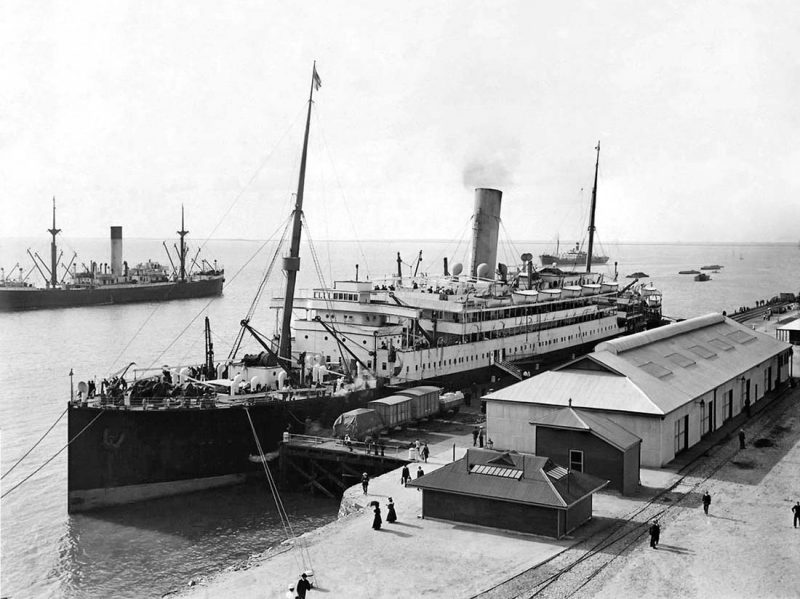
The Maclaren Wharf was completed in 1840 of length 336 feet with an alongside depth of fifteen feet at low water. The wharf warehouse was completed in October 1840 and a new road was opened by Governor Gawler at the same time. Port Adelaide consists of an Outer Harbour and an Inner Harbour, the latter reached by a sharp turn to starboard on entry with Torrens Island to port. In 1875, three masted hard sailed clippers regularly made the long passage from The Downs, Isle of Wight, Start Point or Falmouth in 82 to 96 days to Adelaide. They then either loaded wool in the Spencer Gulf or more likely moved to Chinese ports to load tea and race each other homewards to get the best price from London tea agents as the first cargo to reach home of the new season.
The construction of wharves at the Outer Harbour including the long Queen’s Wharf came just before and around the turn of the century in 1900, and thus accommodating larger deep draft ships, and reducing the time needed to sail up the Port River to the Inner Harbour. Electric street lighting began, and electric trams began to move around Adelaide and to the Port of Adelaide from 1900. Troopships left Port Adelaide in 1915 with many troops for the Anzac regiments that fought at Gallipoli. The first wharf of the port was removed in the 1920s, and during the inter war years Port Adelaide underwent a significant wharf construction programme to utterly change the face of the Inner Harbour.
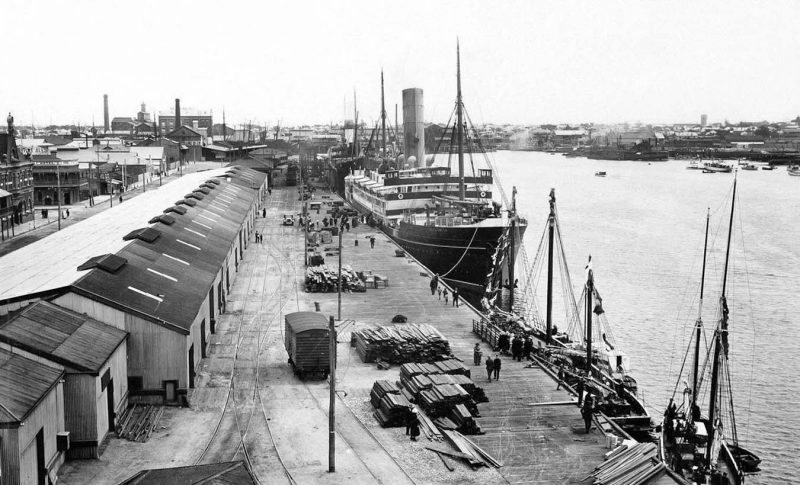
Shipbuilding was increased during World War II, and Port Adelaide was a very busy port of call for liners and cargo-liners of all nations up to 1970. Containerisation and the manufacture of cars at Adelaide led to the import and export of manufactured goods in containers and the export of vehicles and wheeled traffic in ro-ros from the early 1970s. Adelaide currently manufactures over half of all vehicles built in Australia, and its other important industries are electronics, warship production, wines and beers, manufactured goods, and news and media organisations such as the News Corporation of Rupert Murdoch, which was founded here. The current berth details and cargoes imported and exported are given later in this article.
The State of South Australia announced its intention to privatise its Ports Corporations in Millennium year. The Port Adelaide and six Spencer Gulf port businesses were acquired in 2001 by Flinders Ports Pty Ltd. on a 99 year lease of land and port water area. The twenty wharves of the Inner Harbour and Outer Harbour of Port Adelaide are extremely busy, with its primary export partners being the Middle East and all parts of Asia, while its primary import partners are the United States of America, South East Asia, China, Japan and other parts of Asia.
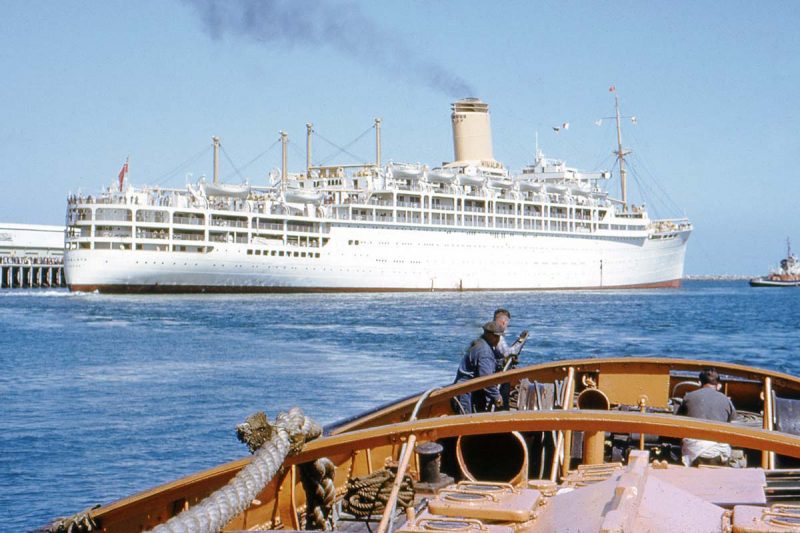
Shipbuilding At Port Adelaide
A yard was cleared out of the mangrove swamps in the Inner Harbour in 1919 known as the Osborne yard of Poole & Steel Ltd., with a long frontage of length 800 feet and a workshop of length 384 feet and width of 128 feet, and with rail tracks, slipways and cranes. A contract was obtained from the Commonwealth Government Line of Australia for four standard sisters of 5,500 dwt on dimensions of length 331.0 feet, moulded beam of 48.0 feet, and moulded depth of 26.0 feet. The keel was laid for the first ship in January 1920 and launched as Eurimbla in April 1921 and completed in November 1921. The second keel was laid in July 1920 and launched in 1921 as Euwarra and completed at the end of the year, while the third ship was completed in 1922 as Eugowra but had been launched as Erina. The fourth ship of the contract was cancelled, with the completed trio sold to the Broken Hill Proprietary Co. Ltd. (BHP) and given ‘Iron’ prefixes to their names. The yard then built two dredgers and some barges for the South Australian State Government, and then diversified into building rail wagons for the South Australian Railways and steel beams for the new bridge at Murray Bridge. The yard was sold in 1937 to the South Australian State Government and the site is now occupied by a power station.
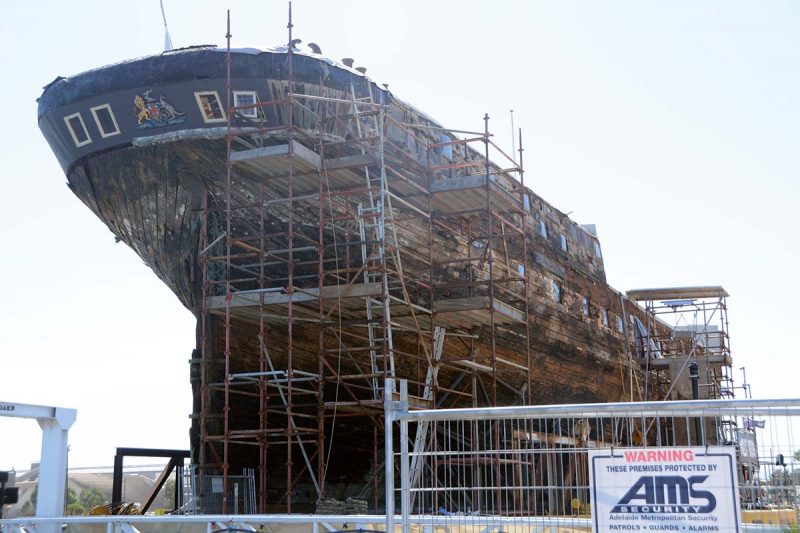
Adelaide Ship Construction Ltd. was incorporated in July 1957 to build tugs on a single slipway on a two acre site, later expanding to four slipways on a 6.5 acre site in 1968 and building ships and coasters up to 425.0 feet in length. The maximum work force was one thousand men in the early 1970s, but the last ship Cape York was completed just before the yard closed in 1973. Adelaide Ship Construction International Ltd. was then established in 1980 to build fishing trawlers on the North Arm of the Port river. It expanded to five slipways with prefabricated sections supplied by large undercover shops, and in 1992 it moved into the international trawler market building prawn trawlers and tuna purse seiners up to 1,200 grt as well as harbour tugs.
North Arm Slipway Pty Ltd. was established in 1977 to build fishing vessels, harbour tugs and small ferries such as Capt. Matthew Flinders of 746 grt and completed in 1984. This ferry was later sold to Mariposa Cruise Line Ltd. of Toronto and kept her name with port of registry then changed to Toronto. The yard continued to build small vessels for a few more years until closure.
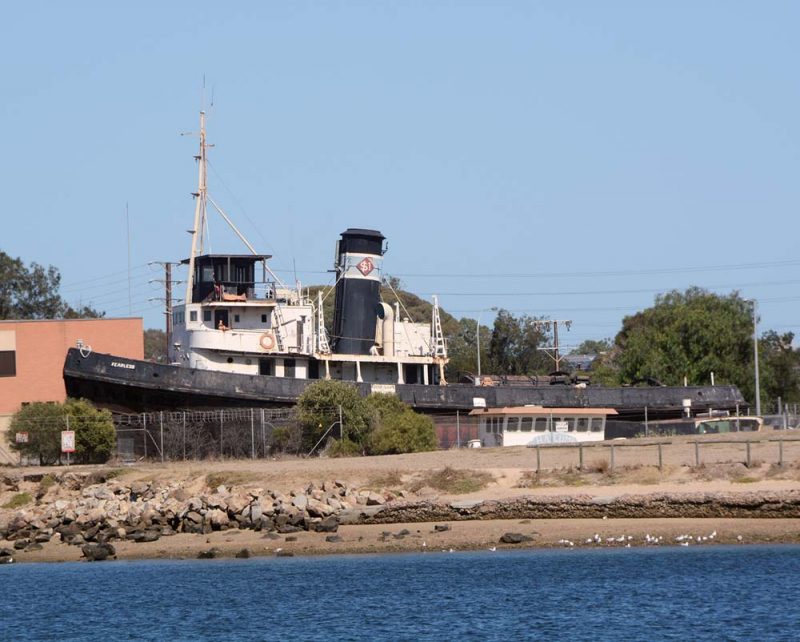
Australian Submarine Corporation (ASC) was established in 1985 to build six ‘Collins’ class submarines for the Royal Australian Navy. The first keel was laid in 1990 and delivered as HMAS Collins in 1996, with the remaining submarines completed up to March 2003. Multi-million dollar contracts for three air warfare destroyers were then signed in October 2007 for this yard located across the river from the Adelaide Ship Construction International Ltd. yard. The Osborne North shipyard at Port Adelaide will be redeveloped as the site of a new submarine construction yard for the Royal Australian Navy, with a plan submitted in August 2018 to Port Adelaide Enfield Council for Phase 1 of work on the Osborne North Shipyard costing $535 million. The yard will build twelve submarines with ground preparation work begun at the end of 2018.
Adelaide Steamship Company Ltd.
This Adelaide based company was founded in 1875 and for the next ninety years was one of the largest coastal passenger and cargo shipping ventures in Australia. Coastal cruises from Adelaide lasting seven days were advertised from 1910 into all of the Spencer Gulf grain ports and were very popular from 1910 until the 1960s. Inter State services ran from Adelaide west to Albany and Fremantle, or eastwards to Melbourne, Sydney, Brisbane and ports as far north as Townsville, Cairns and Darwin. The Spencer Gulf Steamship Company was absorbed in 1882 and it later also controlled the Adelaide Steam Tug Co. Ltd., Coast Steamships Ltd., Adelaide Airways Ltd., Adelaide Ship Construction Co. Ltd., and the Waratah Steam Tug and Salvage Co. Ltd. The company acquired a minority stake in Bulkships Ltd. in 1958, and ten years later owned 50% of this company with McIlwraith McEacharn Ltd. owning the other half. In 1964, the Adelaide Steamship Co. Ltd. merged with McIlwraith McEacharn Ltd. to form Associated Steamships Ltd.
The Adelaide fleet had a yellow funnel with a black top, and a white houseflag with a blue St. George cross and a red central eight pointed star. There were two dozen ships in the fleet in 1920, including some of their famous ‘M’ class passenger ships. The more famous of this ‘M’ class included:-
- Morialta of 1,848 grt built in 1911 which was sold to Hong Kong owners in 1920 and renamed Hailoong, but returned two years later to Australian waters for the Newcastle and Hunter River Steamship Company of Newcastle. She was beached after a collision in 1942 with the vessel Neo Hebridais and later broken up.
- Milluna 5,129 grt ex Mabel Rickmers, and Merriwa of 5,091 grt ex Willy Rickmers and both built in 1914/15 by the Rickmers Werft yard in Bremerhaven for the Rickmers fleet of passenger and cargo-liners with accommodation for fifty passengers. They became German prize ships for the War Controller in 1919 and were sold to the Adelaide Steamship Co. Ltd. in 1920. Merriwa was sold back to German owners in 1928 and renamed Ditmar Koel, and was later sunk by a mine on 22nd May 1941 as the Kate Grammerstorf. Milluna was sold to the European Shipping Co. Ltd. of London without change of name in 1931, and two years later became Mouni for Italian owners and then Tambien in 1936 before being torpedoed and sunk by the British submarine Upholder (Commander Wanklyn) in 1942.
- Mulcra of 1,200 grt built in 1925, and Mundalla of 3,038 grt, built in 1926 were both motorships by Burmeister and Wain at Copenhagen. Mulcra was sold in 1961 and broken up in 1976, while Mundalla was sold in 1960 and broken up ten years later.
- Minnipa of 2,014 grt built in 1927 was also built by Burmeister and Wain at Copenhagen, and served the company for 33 years before her sale in 1960 to be renamed Mayon under the Panamanian flag and was broken up in 1963.
- Manunda of 9,155 grt was completed in 1929 by the William Beardmore yard on the Clyde with accommodation for 176 First Class passengers and 136 in Second Class, and was a twin screw motorship with a service speed of 17.5 knots. She could be identified by the longer than usual hold between the navigating bridge and funnel, and had an overall length of 447.9 feet and a moulded beam of 60.2 feet. She was sold in 1956 to Japanese owners and renamed Hakone Maru and broken up a year later.
- Moonta of 2,693 grt was completed in 1931 by the famous Burmeister and Wain yard in Copenhagen and fitted with their oil engines to give a service speed of thirteen knots, and had accommodation for 140 passengers. She was sold in 1959 to Hellenic Mediterranean Lines of Greece and renamed Lydia, and in 1967 she was beached in the South of France as a hotel and restaurant ship.
- Manoora of 10,856 grt was a graceful liner completed in 1935 by the Alexander Stephen yard on the Clyde with good, enclosed Promenade and Bridge decks, and accommodation for 430 passengers in two classes. She was a motorship with a service speed of 18.5 knots for the important East Coast of Australia service from Adelaide. She had an overall length of 482.0 feet with a moulded beam of 66.2 feet, and after 26 years of service with the company she was sold in 1961 to the Indonesian Government and renamed Ambulombo, becoming Affan Oceana two years later, and Ambulombo again in 1966, but sank off Luzon in 1972 on her last voyage to shipbreakers in Taiwan.
The Spencer Gulf Grain Races
The largest four masted sailing ships in the world capable of carrying up to 6,000 tonnes of grain that were still afloat at the end of the Great War were mostly owned by the famous Aland Islands fleet of Finnish shipowner Gustav Erikson of Mariehamn, and the equally famous ‘Flying P’ fleet of Frederick Laeisz of Hamburg. These great ships usually left Northern European ports in September of each year in ballast bound for the nitrate ports of Chile or the grain ports of the Spencer Gulf. Some would be loaded with Baltic timber for the mines of South Africa, and unloaded in Durban, and then the barques traversed the Indian Ocean in November in order to reach South Australia and the Spencer Gulf ports in December. There were six Spencer Gulf grain loading ports in the inter-war years, with the ships all being loaded at around the same time, and thus sailed in a competitive yearly event to Europe known as ‘The Grain Races’.
The record for the fastest ever passage was held by the Parma owned by Laeisz, which reached Europe in a very fast 83 days in 1933 under Capt. Ruben de Cloux. Herzogin Cecilie, in my opinion, was the most beautiful of these big grain ships, and came close to this record in 1931 with 93 days from Wallaroo to Falmouth, and again in 1936 with 86 days from Port Lincoln to Falmouth on her voyage that ended with her sad grounding on Ham Stone Rock under Bolt Head in South Devon on 25th April 1936. She was refloated and towed to the nearby Kingsbridge Estuary near Salcombe but capsized and sank there on 18th January 1939. She had been launched on 22nd April 1902 at Bremerhaven for Norddeutscher Lloyd on dimensions of overall length 102.0 metres, moulded beam of 14.0 metres, and loaded draft of 7.37 metres.
The last big race occurred in 1934 when eighteen great sailing ships named Olivebank, Parma, Viking, Pamir, Pommern, Mozart, Gerard, Killoran, Lurline, Broughton, Forbes Brothers, Wairmara, Nelcebee, Moorara, Leeta May, Ena and Yalata mostly sailed from Port Victoria, with the famous Lawhill loaded with grain and sailing from Adelaide, in January of that year. A total of 23 fast passages of under one hundred days were made during the inter-war years by the big four masted barques Passat, Pamir, Herzogin Cecilie, Pommern, Moshulu, L’Avenir, Viking, Ponape and Grace Harwar. These fastest ever passages of under one hundred days also included the barque Marlborough Hill with 91 days in 1921 from Port Lincoln to Cobh, Priwall with 91 days in 1935 from Port Victoria to Cobh, Pommern and Passat with 94 days both from Port Victoria to Falmouth in 1937, Passat with 98 days in 1938 between the same two ports, and the great Moshulu ex Kurt with 91 days in 1939 from Port Victoria to Cobh as the largest sailing ship in the world at that time, and thankfully preserved today as a restaurant ship at Philadelphia. The beautiful Herzogin Cecilie won ‘The Grain Race’ six times, each passage being of under one hundred days, and she received an inscribed silver cup donated by the International Paints Company of Gateshead in 1928. The consistently fastest of these great four masted barques, with their average passage times and numbers of races, were:-
| Ship | Av. voyage (days) | No. | Period |
| Passat | 99 | 7 | 1933-1939 |
| Pamir | 102 | 7 | 1932-1939 |
| Moshulu | 106 | 4 | 1936-1939 |
| Herzogin Cecilie | 107 | 11 | 1926-1936 |
| Pommern | 108 | 11 | 1929-1939 |
| L’Avenir | 113 | 5 | 1933-1937 |
| Ponape | 114 | 7 | 1929-1936 |
| Parma | 115 | 5 | 1932-1936 |
| Archibald Russell | 115 | 14 | 1925-1939 |
| Viking | 116 | 9 | 1931-1939 |
| Lawhill | 121 | 14 | 1921-1939 |
| Killoran | 125 | 10 | 1927-1939 |
| Grace Harwar | 127 | 8 | 1921-1936 |
| Winterhude | 133 | 8 | 1932-1939 |
Herzogin Cecilie made an uncharacteristically long passage of 137 days in light winds in 1926 that lifted her average passage time over eleven voyages to 107 days instead of 105 days. She was owned in her later years by Gustav Erikson of Mariehamn, who owned the large total of 46 sailing ships between 1913 and 1957, with the last being Pamir sunk with all hands in the North Atlantic in 1957. He also owned a minority interest in 47 other sailing ships, while Frederick Laeisz of Hamburg owned around ninety sailing ships between 1839 and 1946. There were eight ‘Flying P’ sisters over one hundred metres in length with gross tonnages of between 3,060 and 3,100, and deadweight tonnages of between 4,550 and 4,875, named Pangani of 1903, Petschili of 1903, Pamir of 1905, Passat of 1911, Peking of 1911, Pola of 1916, Priwall of 1917 and Padua of 1926.
Port Adelaide Current
Facilities
Port Adelaide was founded 180 years ago as one of the earliest settlements in South Australia, and became the first State Heritage Area of South Australia in the 1980s. It is located at position 35°51′ South, 138°30′ East, with both an Outer Harbour and an Inner Harbour. VHF radio telephone communications on channels 12 and 16 use the call sign ‘Adelaide Outer Harbour’, with additional channels working on 6, 8 and 67. Port Adelaide is the maritime gateway to South Australia, handling a diverse range of imported and exported cargoes, including grains and seeds, limestone, meat, logs, sulphur, paper products, livestock, timber, petroleum products, motor vehicles and wheeled traffic, cement and cement clinker, fertilisers, agricultural commodities, iron ore and iron and steel, scrap metals, break bulk and general cargo, mineral sands and commodities, and a large number of containers. These are handled at the following eight berths in the Outer Harbour (OH1 to OH8), and twelve berths in the Inner Harbour, with alongside depths, berth lengths and width, and maximum vessel dimensions in metres:-

| Berth | Depth | Length | Width | Max LOA | Max Beam | |
| 18 | 10.0 | 178.0 | 36.0 | 206.0 | 32.26 | Fertilisers, scrap metal, textiles, acids |
| 19 | 10.0 | 168.0 | 36.0 | 206.0 | 32.26 | As Berth 18 plus forestry products |
| 20 | 10.0 | 163.0 | 36.0 | 206.0 | 32.26 | As Berth 19 |
| 25 | 10.2 | 240.0 | 35.0 | 206.0 | 32.26 | Stores and lay-up |
| 27 | 10.9 | 224.0 | 36.0 | 206.0 | 32.26 | Grains and seeds |
| 29 | 10.0 | 290.0 | 36.0 | 206.0 | 32.26 | Mineral sands, livestock, sulphur etc |
| H | 11.2 | 304.0 | 36.0 | 206.0 | 32.26 | Cement and cement clinker |
| K | 7.5 | 171.0 | 25.0 | 102.0 | – | Limestone |
| M | 10.7 | 218.0 | 35.0 | 206.0 | 32.26 | Petroleum products |
| N | 7.8 | 100.0 | 25.0 | 140.0 | – | Bulk liquids |
| OSB4 | 7.5 | 120.0 | 30.0 | 120.0 | – | General cargo |
| OSB1 | 10.0 | 208.0 | 30.0 | 170.0 | – | Acid, break bulk, grain, cement |
| OH1 | 11.5 | 185.0 | 37.0 | 300.0 | 36.0 | General cargo and lay-up |
| OH2 | 11.2 | 183.0 | 37.0 | 300.0 | 36.0 | Passenger Terminal, autos, iron ore |
| OH3 | 11.2 | 150.0 | 37.0 | 300.0 | 36.0 | Wheeled traffic |
| OH4 | 13.8 | 214.0 | 37.0 | 300.0 | 36.0 | Petroleum products |
| OH6 | 14.2 | 300.0 | 40.0 | 300.0 | 36.0 | Flinders Adelaide Container Terminal |
| OH7 | 14.2 | 323.0 | 40.0 | 300.0 | 36.0 | Flinders Adelaide Container Terminal |
| OH8 | 16.2 | 320.0 | 50.0 | 300.0 | 36.0 | Grains and seeds |
The Outer Harbour vessel limitations are a maximum length overall of 300.0 metres, maximum beam of 36.0 metres, alongside depth of 14.2 metres, an average high spring tide of 2.4 metres, and an average high neap tide of 1.3 metres. There are two swinging basins, the first at the OH2 Passenger Terminal with a diameter of 400.0 metres, and the other opposite berth OH6 with a diameter of 505.0 metres. The Inner Harbour vessel limitations are a maximum length overall of 206.0 metres, maximum beam of 32.2 metres, alongside depth of 9.3 metres, average high spring tide of 2.4 metres, and an average high neap tide of 1.3 metres. The swing basin is just south of berth 27 with a diameter of 330.0 metres.
BP Australia has since October 2016 installed a new pipeline facility at N berth in the Inner Harbour for vessels up to 120.0 metres in length and a draft of 8.0 metres and a flow rate of 130 cubic metres per hour. This operates only in daylight hours under the management of Australian Terminals Operations Management. CALTEX have a bunkering facility at OH4 as a common user fuel berth, capable of handling medium range and long range tankers. The berth is compliant with Australian Standards and International Safety Guides for oil tankers in both categories. The maximum vessel length overall is 300.0 metres, and maximum beam of 36.0 metres.
The Flinders Adelaide Container Terminal at berths OH6 and OH7 is the only container terminal in South Australia with a total length of 600.0 metres. The terminal handles seven direct shipping services that link Adelaide to international ports in South East Asia, Northern Asia, the Indian sub-continent, Europe and North America, as well as one fortnightly direct service. There are three Post Panamax Gantry Cranes manufactured by Liebherr, 22 straddle carriers, and dozens of reach stackers and forklifts. Two of the Post Panamax Gantry Cranes were installed in July 2015 with 35 TEU moves per hour and a maximum lift of 80 tonnes. Container vessels of Maersk Line, CMA CGM, MSC, ANL Container Line, APL Lines, Hamburg Sud and Hapag Lloyd, the Chinese lines of OOCL, COSCO and CSCL and their Australian subsidiary of OOCL Australia Pty, the Japanese ‘ONE’ consortium of NYK, Mitsui OSK and ‘K’ Line, and Pacific International Lines (PIL), and many other container lines including UASC call at Port Adelaide. The Container Terminal has adequate yard storage space as well as a ro-ro quarter ramp, and is served by two dual gauge rail tracks linked directly to the national rail network. There are a large number of reefer container plugs, and the terminal has full inter-modal facilities to move containers from road to rail.
Iron ore exports by CU River of Australia exceeded expectations during 2017, as the company is one of only two such exporters in South Australia. Iron ore production of almost one million tonnes was achieved by mines over 800 kilometres from Port Adelaide. A very efficient tippler loading system gave the mine company and the Port of Adelaide two awards for the Australian Bulk Handling Facility of the Year Award in 2016 and 2017. The Cairn Hill mine of CU River employs sixty staff and has expansion plans for a second mine. The eventual export target of iron ore from the Outer Harbour and Inner Harbour at Port Adelaide is around an annual 1.8 million tonnes, while South Australia as a whole is gearing up for a mining production target of around 30.0 million tonnes by the year 2030.
Towage at Port Adelaide is provided by Svitzer Australia at Dock 2, Ocean Steamers Road, in Port Adelaide. Towage at the six small ports of the Flinders Ports Pty Ltd. is provided by Port Lincoln Tugs Pty Ltd., founded in 1967, with a fleet of six tugs in Bulimba 265/1979 and a bollard pull of 41 tonnes, Capel 163/1976 with a bollard pull of 34 tonnes, Kioloa 231/1975 with a bollard pull of 40 tonnes, Lucinda 250/1975 with a bollard pull of 27 tonnes, Wangary 268/76 with a bollard pull of 42 tonnes, and Ungarra 103/68 with a bollard pull of 15 tonnes. Port Adelaide Marine are the agents for Port Lincoln Tugs Pty Ltd. Two new pilot boats began service at Port Adelaide in June 2018 named Providence and Norfolk, both ships that Capt. Matthew Flinders (1774-1814) served on at sea. Flinders was an English navigator and cartographer and the leader of the first circumnavigation of Australia and he identified it as a continent. He made three voyages to the southern oceans from England between 1791 and 1810.
Port Adelaide Cruise Ship Calls
Cruise ships call at Port Adelaide and at Penneshaw on the eastern point of Kangaroo Island and at Port Lincoln during the six month cruise season from October to April to see the cultural sights of Adelaide and neighbouring communities as well as the Wildlife Heritage Areas of Kangaroo Island and its animals, flora and fauna.
It should be noted that the cruise ship calls listed below include some multi-port calls by several cruise ships calling at Port Adelaide, Penneshaw and Port Lincoln on the same voyage.
| P &O. Australia | 25 |
| Princess Cruises | 13 |
| Holland America Line | 11 |
| Cruise & Maritime Voyages (CMV) | 7 |
| Regent Seven Seas/Oceania Cruises | 7 |
| Cunard Line | 7 |
| Seabourn Cruises | 3 |
| Royal Caribbean International | 2 |
| Azamara Cruises | 2 |
| Crystal Cruises | 2 |
| Phoenix Seereisen | 2 |
| Celebrity Cruises | 1 |
| Silversea Cruises | 1 |
| Fred Olsen Cruises | 1 |
| Aida Cruises | 1 |
| Carnival Cruises | 1 |
| Peace Boat Travel | 1 |
| TOTAL | 87 |
Port Pirie
Port Pirie is located on the eastern side of the Spencer Gulf towards its upper reaches at position 23°10′ South, 138°02′ East. It has been an industrial mining and grain exporting port for over a century, and is home to the giant Nyrstar concentrates smelter, one of the largest smelters in the world. The call sign ‘Port Pirie Harbour’ is used on VHF radio telephone channels of 6, 8, 12, 16 and 67. The principal commodities shipped are mineral commodities, mineral by-products, coal and general cargo. The entrance channel to the port is nine nautical miles in length, with a minimum depth of 6.5 metres, and a maximum width of ninety metres. The swing basin is off Berth 6 and has a diameter of 325.0 metres. The eight berths at the port with alongside depths, berth lengths and widths, and maximum vessel dimensions in metres are:-
| Berth | Depth | Length | Width | Max LOA | Max Beam | |
| 2 | 8.2 | 190.0 | 30.0 | 185.0 | 28.0 | General cargo |
| 4 | 5.8 | 107.0 | 25.0 | – | – | Tug and pilot boat berth |
| 5 | 8.2 | 198.0 | 30.0 | 185.0 | 28.0 | General cargo |
| 6 | 8.2 | 183.0 | 30.0 | 185.0 | 28.0 | Ores and concentrates |
| 7 | 8.2 | 145.0 | 30.0 | 185.0 | 28.0 | General cargo and containers |
| 8 | 8.2 | 180.0 | 30.0 | 185.0 | 28.0 | Ores and concentrates |
| 9 | 8.2 | 180.0 | 30.0 | 185.0 | 28.0 | Ores, concentrates and coal |
| 10 | 8.2 | 180.0 | 30.0 | 185.0 | 28.0 | Bulk imports |
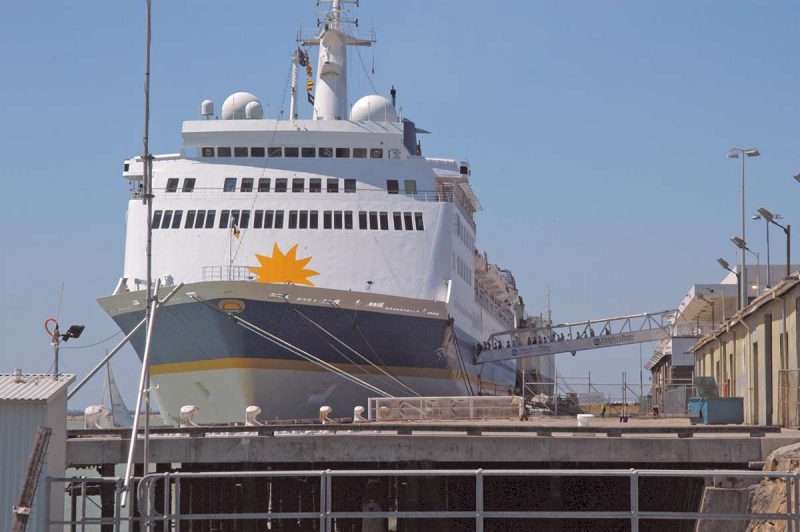
Port Lincoln
Port Lincoln was a major wheat loading port during the Spencer Gulf Grain Races of the inter-war years, and is located at position 34°43′ South, 135°50′ East on the south western extremity of the Spencer Gulf. It is a massive 682 kilometres from Port Adelaide by road, and has a fine natural harbour. The average high spring tides are only 1.34 metres, and the average high neap tides are only 0.87 metres. The port uses the call sign ‘Port Lincoln Harbour’ on VHF radio telephone channels 6, 8, 12, 16 and 67, and the Berth 11 for petroleum products is at Kirton Point. The eight berths at the port with alongside depths, berth lengths and widths, and maximum vessel dimensions in metres are:-
| Berth | Depth | Length | Width | Max LOA | Max Beam | ||
| 4 | 15.2 | 330.0 | 65.0 | 270.0 | 33.0 | Grains and seeds | |
| 5 | 15.2 | 330.0 | 65.0 | 270.0 | 33.0 | Grains and seeds | |
| 6 | 12.2 | 250.0 | 46.0 | 200.0 | 30.0 | Fertilisers | |
| 7 | 8.4 | 183.0 | 25.0 | 185.0 | 26.0 | Fishing vessels | |
| 8 | 5.7 | 78.0 | 25.0 | 78.0 | 15.0 | Fishing vessels | |
| 9 | 4.6 | 107.0 | 25.0 | 107.0 | 15.0 | Ro-Ro cargoes | |
| 10 | 0.2 | 35.0 | 18.0 | 56.0 | – | Fishing vessels | |
| 11 | 9.9 | 280.0 | 40.0 | 220.0 | 30.0 | Petroleum products |
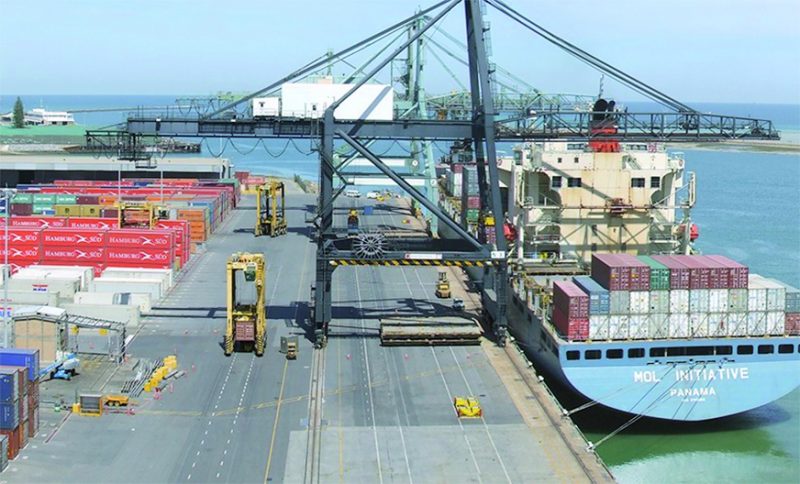
Port Giles
Port Giles is located at position 35°02′ South, 137°46′ East on the south eastern part of the Yorke Peninsula. It lies 217 kilometres by road from Port Adelaide, and was established in 1970 to export grains and seeds from the lower part of the Yorke peninsula. The main commodities shipped from a single pier are grains and seeds, with an alongside depth of 14.7 metres, berth dimensions of 340.0 metres by 40.0 metres, and maximum vessel dimensions of 230.0 metres by 30.0 metres. Vessel sailings are permitted day or night, but vessel berthing is only permitted during daylight hours. The call sign ‘Adelaide Outer Harbour’ is used on radio telephone channels 6, 8, 12, 16 and 67. Port Giles has average high spring tides of only 2.0 metres, and average high neap tides of only 1.2 metres. The maintained channel into the port has an average depth of 13.5 metres.
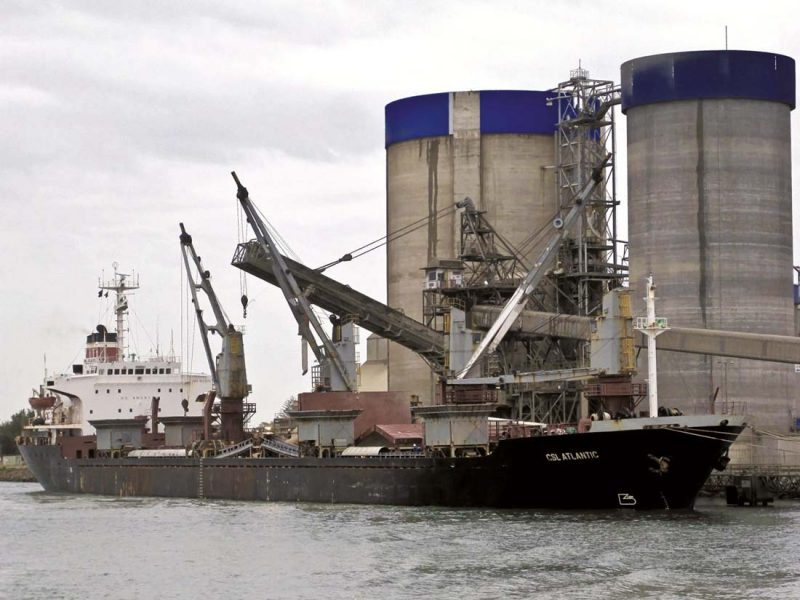
Klein Point
Klein Point is located at position 34°58′ South, 137°46′ East, and has a single ‘T’ junction loading jetty to handle exports of limestone on the south eastern part of the Yorke Peninsula. The bulk handling facility is privately owned, but the port is managed by the Flinders Ports Pty Ltd. VHF radio telephone is used for vessel movements, and the maximum entrance channel depth is 6.5 metres and the same at the loading jetty. The loading jetty berth has a length of 150.0 metres and width of 30.0 metres, with maximum vessel dimensions permitted being 130.0 metres length and 30.0 metres in the beam.
Thevenard
The Port of Thevenard is located at position 32°09′ South, 133°39′ East on the Great Australian Bight off South Australia. It is 793 kilometres west of Port Adelaide, and three kilometres from the centre of Ceduna, a small town with a population of just over four thousand people. The average high spring tide is only 1.67 metres, and the average high neap tide is only 1.08 metres. The port uses the call sign ‘Thevenard Port Control’ in VHF radio telephone communications on channels 6, 8, 12, 16 and 67 to vessels entering the port to load gypsum, grains and seeds, salt and mineral sands. There are two berths at the port, with the North Berth and the South Berth both having an alongside depth of 9.8 metres, berth length of 198 metres by 30.0 metres, with maximum vessel dimensions permitted of 185.0 metres length and 32.0 metres in the beam. The bulk carrier CSL Thevenard is a regular caller at the port, and has a deadweight of 40,734 tonnes on dimensions of length 185.0 metres, moulded beam of 32.0 metres, and a loaded draft of 8.0 metres. She was built as Polystar in 1981, but is now owned by Canada Steamships Ltd. (CSL) and wears their red, white and blue banded funnel, and has a very long boom conveyor belt system.
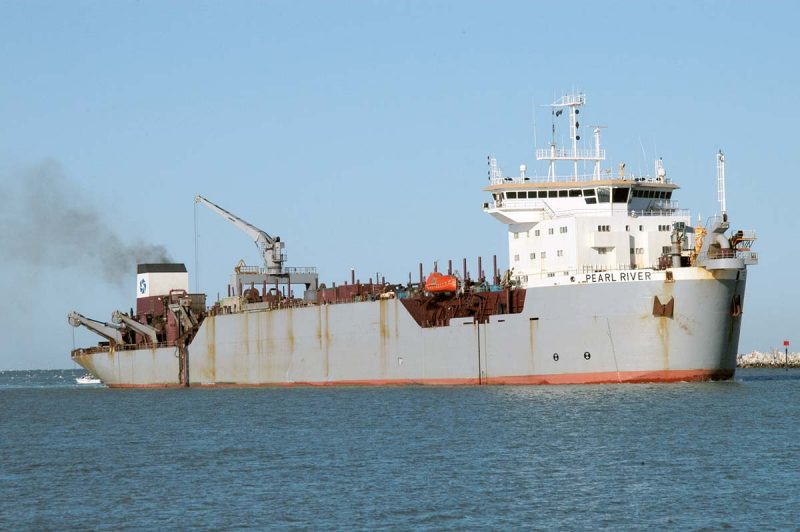
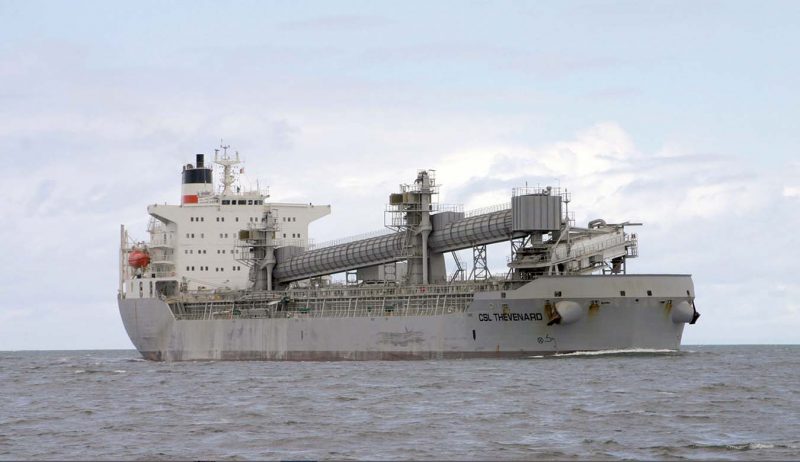
Wallaroo
The Port of Wallaroo is located at position 33°56′ South, 137°39′ East on the Eastern side of the Spencer Gulf. It lies 158 kilometres north west of Port Adelaide and has a population of around 2,500 people. The loading berth for grains and seeds is at the end of a pier angled from the shore, with the conveyor belt transporting the cargo joining the pier at its midway point. The average high spring tides are only 1.21 metres, and the average high neap tides are only 0.88 metres in height. The call sign ‘Wallaroo Harbour’ is used on the VHF radio telephone channels 6, 8, 12, 16 and 67. The maintained depth in the channel is 8.4 metres, and ships berth on both the north and south sides of the loading pier. The north berth has an alongside depth of 9.5 metres, with berth dimensions being 310.0 metres by 36.0 metres and maximum vessel permitted dimensions of 230.0 metres by 32.0 metres. The south berth has an alongside depth of 9.3 metres, with berth dimensions being 245.0 metres by 36.0 metres and maximum permitted vessel dimensions of 230.0 metres by 32.0 metres.
Whyalla
Whyalla Steelworks is a fully integrated steelworks and the only manufacturer of rail lengths in Australia. Iron ore is mined in the Middleback Range of mountains to the north to feed the blast furnaces of the steelworks, which manufactures over ninety different grades of finished steel products with a total annual production of 1.2 million tonnes of steel. Steel billets are made from 65% of this production at a rolling mill. The Port of Whyalla first shipped iron ore by sea in 1903 to Port Pirie from mines named after the laconic Iron Knob, Iron Monarch, Iron Baron, Iron Knight, Iron Princess, Iron Chieftain and Iron Duke. The mines were developed by the Broken Hill Proprietary Company (BHP), which opened a steelworks at Whyalla in May 1941, and a shipyard later in the year.
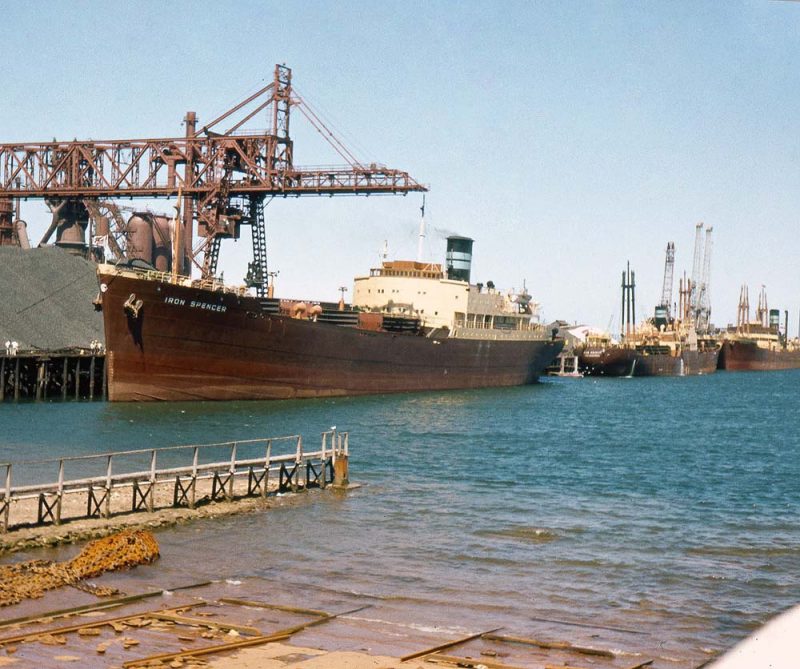
The rooftops of houses at Whyalla were often covered with orange dust from the Whyalla steelworks, until this was reduced by transporting the iron ore from the Iron Duke mine by a slurry pipeline to Whyalla. The Port of Whyalla is not managed by Flinders Ports Pty Ltd., but by OneSteel, which was spun off from BHP and renamed as OneSteel in Millennium year. The majority of the water used by the Whyalla steelworks is pumped from Morgan on the Murray river to Whyalla.
The shipyard at Whyalla built 64 ships between 1941 and 1978, with the first four yard numbers being corvettes for the Royal Australian Navy in 1941 named HMAS Whyalla, Gawler, Kalgoorlie and Pirie. HMAS Whyalla was preserved at the end of her active service and now sits in a dry-dock at the Whyalla Visitors Centre. Fifteen iron ore carriers and bulkers were built for the BHP company from 1942 until the last pair were completed in 1977/78 as the sisters Iron Carpentaria and Iron Curtis of 45,430 dwt. Twenty general cargo ships, colliers, bulkers and ro-ro ships were built for Australian National Line (ANL) between 1943 and 1965, with the largest being the bulker Darling River of 49,780 dwt in 1965. The five hold bulker Lake Illawarra of 10,160 dwt sank after colliding with the Tasman Bridge at Risdon in Tasmania on 5th January 1975, resulting in the deaths of twelve people including five motorists. Six tankers were built for Shell, Ampol, Mobil, R. W. Miller and the Botany Bay Tanker Company Pty Ltd., with the tanker P. J. Adams as yard number 35 in 1962. The shipyard had two building berths, number one with a length of 835 feet for building vessels up to 78,000 dwt, and number two with a length of 700 feet for vessels up to 35,000 dwt.
The Port of Ardrossan is located on the East coast of the Yorke peninsula and lies about 150 miles by road from Port Adelaide. It has a deep water shipping harbour for the export of dolomite, the latter being an essential additive in the steel making process. The existing mine and port were formerly regulated by Ausbulk Ltd., but are currently owned and managed by OneSteel of Whyalla.
Postscript
The clipper ship City of Adelaide was launched at the Sunderland yard of William Pile, Hay & Company on 7th May 1864, and currently lies on a barge at Dock 1 in the Inner Harbour of Port Adelaide some 154 years later. She made 23 annual return voyages from London and Plymouth to Adelaide with passengers and general cargo, returning with wool and copper from Port Augusta. In 1888, she began to trade with timber across the North Atlantic, and then became a floating hospital at Southampton in 1893. She was purchased by the Royal Navy in 1923 as the training ship Carrick based at Glasgow, later becoming the Royal Naval Volunteer Reserve Club ship until 1948. She remained on the Clyde until 1989 when she was damaged by flooding and she sank at her mooring in 1991. The Scottish Maritime Museum refloated her but funding for restoration was elusive and she was moved to Irvine until funding ceased in 1999. The Scottish Government decided she should be moved to Adelaide, and she arrived on the deck of the German heavy lift ship Palanpur on 3rd February 2014. She was transferred to a barge and towed to the Inner Harbour, where she currently awaits a final berth.
Adelaide has a population of 1.34 million people and has a beautiful ring of parkland around the Torrens river, and with the important Art Gallery of South Australia, the South Australia Museum, the National Wine Centre of Australia, and the Adelaide Botanic Gardens. The South Australia Maritime Museum was opened in 1986 in two former bonded warehouses built in the 1850s. As well as a host of indoor attractions e.g. many figureheads of sailing ships, one can visit the Port Adelaide Lighthouse built in 1869, and cruise on the steam tug Yelta built in Australia in 1949, and the former naval launch Archie Badenoch of 1942, and the ketch Nelcebee, as well as book a tour to the Torrens Island Quarantine Station on the other side of the Inner Harbour.

On a personal level, the ‘Seawolf’ missile system that I worked on for several years was live tested at the Woomera firing range located 280 miles (450 kilometres) north west of Adelaide in the early 1970s. Woomera has been a live missile firing base since 1947 to the present day, with ‘Seawolf’, a Royal Navy radar and computer controlled anti-Exocet and anti-aircraft missile, being tested here, and at the Aberporth firing range at targets in Cardigan Bay, and at the firing range at South Uist in the Outer Hebrides, missiles being harmlessly fired into the North Atlantic. The advantage of Woomera was, of course, there were no inhabitants in that area of the Outback. Missile designers, engineers and other base personnel were permitted to make the long journey to Adelaide for rest and relaxation, but extra tyres, oil, petrol or diesel, water and food were loaded into the vehicle before setting off. The very strict instructions of ‘Stay by the Vehicle!’ were always obeyed, in order that one could be rescued if and when engine breakdowns or accidents occurred. The Port of Adelaide is a very busy and interesting place to visit
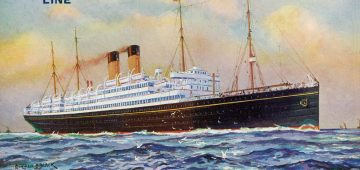



Comments
Sorry, comments are closed for this item